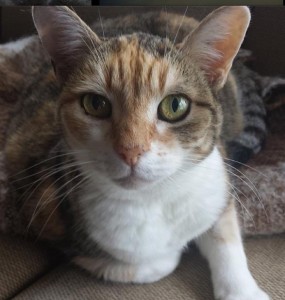 Do you watch cat videos online? Do you take videos of your cats and share them online? Wellington-based lecturer Dr Radha O’Meara of the School of English and Media Studies has been featured in the international media this week after her article about the global phenomenon of cute cat videos was published. Part of a special issue of ‘M/C: A journal of media and culture,’ on cuteness (see http://journal.media-culture.org.au/index.php/mcjournal/issue/view/cute), Dr O’Meara’s article, entitled ‘Do Cats Know They Rule YouTube? Surveillance and the Pleasures of Cat Videos’ analysed cat videos’ appeal, but also interrogated their ultimate purpose. She examined the distinguishing features of contemporary cat videos, focusing particularly on their narrative structure, mode of observation, and mode of performance.
Do you watch cat videos online? Do you take videos of your cats and share them online? Wellington-based lecturer Dr Radha O’Meara of the School of English and Media Studies has been featured in the international media this week after her article about the global phenomenon of cute cat videos was published. Part of a special issue of ‘M/C: A journal of media and culture,’ on cuteness (see http://journal.media-culture.org.au/index.php/mcjournal/issue/view/cute), Dr O’Meara’s article, entitled ‘Do Cats Know They Rule YouTube? Surveillance and the Pleasures of Cat Videos’ analysed cat videos’ appeal, but also interrogated their ultimate purpose. She examined the distinguishing features of contemporary cat videos, focusing particularly on their narrative structure, mode of observation, and mode of performance.
In particular, the article highlights a unique characteristic of these videos: the cats’ unselfconsciousness. This, Dr O’Meara argues, is “rare in a consumer culture dominated by surveillance, where we are constantly aware of the potential for being watched”. The obliviousness of cats in online videos offers viewers two key pleasures, she suggests: to imagine the possibility of freedom from surveillance, and to experience the power of administering surveillance as unproblematic.
Dr O’Meara told Australia’s ABC Radio National that ultimately, however, “cat videos enable viewers to facilitate our own surveillance, and we do so with the gleeful abandon of a kitten jumping in a tissue box.” Unaware of the irony inherent in their actions, cat video viewers enjoy a sense of vicarious freedom, while giving away more of their privacy as their viewing habits are tracked with every click.
Hear the podcast of the full interview at: http://www.abc.net.au/radionational/programs/thelist/beware-the-celebrity-pet/5427546

